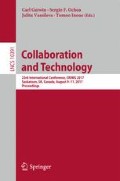Abstract
Teaching and learning in most current university lectures has remained unchanged for centuries and nowadays, large lecture classes are a fact at universities. Technologies such as Classroom Response Systems have been designed to ease the adoption of new pedagogical practice in these contexts; however, these pose technological, economic and pedagogical limitations to teachers, students and institutions. In this paper, we present a feasibility study of a system that allows students to take snapshots of paper-based, handwritten solutions to a given task with their devices, and then converts this input to vector graphics that are automatically hosted in a cloud-based storage service, such as Google Drive. The teacher can then discuss students’ solutions and provide elaborate formative feedback in class. We report on the findings of a feasibility study with engineering students in Chile, which validate the practicality of the approach. After this validation we plan to integrate optical character recognition capabilities in the system, in order to support programming and physics education.
Access this chapter
Tax calculation will be finalised at checkout
Purchases are for personal use only
References
Biggs, J.B.: Teaching for Quality Learning at University: What the Student Does. McGraw-Hill Education, Maidenhead (2011)
Freeman, S., et al.: Active learning increases student performance in science, engineering, and mathematics. Proc. Natl. Acad. Sci. 111(23), 8410–8415 (2014)
Black, P., Wiliam, D.: Developing the theory of formative assessment. Educ. Assess. Eval. Account. 21(1), 5 (2009)
Deslauriers, L., Schelew, E., Wieman, C.: Improved learning in a large-enrollment physics class. Science 332(6031), 862–864 (2011)
Baloian, N., Pino, J.A., Hoppe, H.U.: Dealing with the students’ attention problem in computer supported face-to-face lecturing. Educ. Technol. Soc. 11(2), 192–205 (2008)
Baloian, N., Pino, J.A., Hardings, J., Hoppe, H.U.: Monitoring student activities with a querying system over electronic worksheets. In: Baloian, N., Burstein, F., Ogata, H., Santoro, F., Zurita, G. (eds.) CRIWG 2014. LNCS, vol. 8658, pp. 38–52. Springer, Cham (2014). doi:10.1007/978-3-319-10166-8_4
Yoon, S.A., Koehler-Yom, J., Anderson, E., Lin, J., Klopfer, E.: Using an adaptive expertise lens to understand the quality of teachers’ classroom implementation of computer-supported complex systems curricula in high school science. Res. Sci. Technol. Educ. 33(2), 237–251 (2015)
Herreid, C.F.: “Clicker” cases: introducing case study teaching into large classrooms. J. Coll. Sci. Teach. 36(2), 43 (2006)
Chien, Y.T., Chang, Y.H., Chang, C.Y.: Do we click in the right way? A meta-analytic review of clicker-integrated instruction. Educ. Res. Rev. 17, 1–18 (2016). http://doi.org/10.1016/j.edurev.2015.10.003
Blasco-Arcas, L., et al.: Using clickers in class. The role of interactivity, active collaborative learning and engagement in learning performance. Comput. Educ. 62, 102–110 (2013)
Mazur, E.: Peer Instruction: A User’s Manual. Prentice-Hall, Prentice-Hall (1997)
Crouch, C.H., Mazur, E.: Peer instruction: ten years of experience and results. Am. J. Phys. 69(9), 970–977 (2001)
Camacho-Miñano, M.-D.-M., del Campo, C.: Useful interactive teaching tool for learning: clickers in higher education. Interact. Learn. Environ. 24(4), 706–723 (2016)
Liu, C., et al.: The effects of clickers with different teaching strategies. J. Educ. Comput. Res. (2016). doi:10.1177/0735633116674213
Deal, A.: Classroom response systems, a teaching with technology. White Paper, Office of Technology for Education, Carnegie Mellon University (2007)
Trees, A.R., Jackson, M.H.: The learning environment in clicker classrooms: student processes of learning and involvement in large university-level courses using student response systems. Learn. Media Technol. 32(1), 21–40 (2007)
Adams Becker, S., et al.: NMC/CoSN Horizon Report: 2016K (2016)
Acknowledgements
This research has been partially funded by the Chilean Science and Technology Commission (CONICYT) through grant FI-11160211.
Author information
Authors and Affiliations
Corresponding author
Editor information
Editors and Affiliations
Rights and permissions
Copyright information
© 2017 Springer International Publishing AG
About this paper
Cite this paper
Álvarez, C., Baloian, N., Zurita, G., Guarini, F. (2017). Promoting Active Learning in Large Classrooms: Going Beyond the Clicker. In: Gutwin, C., Ochoa, S., Vassileva, J., Inoue, T. (eds) Collaboration and Technology. CRIWG 2017. Lecture Notes in Computer Science(), vol 10391. Springer, Cham. https://doi.org/10.1007/978-3-319-63874-4_8
Download citation
DOI: https://doi.org/10.1007/978-3-319-63874-4_8
Published:
Publisher Name: Springer, Cham
Print ISBN: 978-3-319-63873-7
Online ISBN: 978-3-319-63874-4
eBook Packages: Computer ScienceComputer Science (R0)

